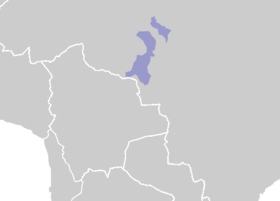| Lenguas nambicuaras | ||
|---|---|---|
| Distribución geográfica | Amazonia suroccidental | |
| Países |
| |
| Hablantes |
~1350 (1999) ~1500 (2009)[1] | |
| Subdivisiones |
Nambikwara Meridional Mamainde-Nakarothe Sabanês | |
 | ||
Las lenguas nambicuranas o nambikwara son una reducida familia de lenguas indígenas de la selva amazónica habladas por diversas etnias nambicuaras, hoy extendida por los estados brasileños de Mato Grosso y Rondonia.
Comprende tres grupos de dialectos (dentro de cada grupo hay inteligibilidad mutua):
- Nambicuara septentrional (135 hablantes): Lakondê Latundê, Mamaindê, Nagarotê y Tawandê (5 en total)
- Nambicuara meridional (1150): o nambikwara propiamente dicho, que incluye once variantes entre ellas:[2] Campo, Manduka, Galera y Guaporé)
- Sabanê (60 hablantes): que no está subdividido porque no presenta variación dialectal.[3]
La mayoría de hablantes de lenguas nambikwara son monolingües aunque algunos hombres jóvenes hablan portugués.[4] Especially the men of the Sabanê group are trilingual, speaking both Portuguese and Mamainde.[5]
YouTube Encyclopedic
-
1/1Views:414
-
Seminario permanente Pedagogías insumisas - Sesión 3. REPES, IAES-CFE
Transcription
Comparación léxica
Los numerales en diferentes lenguas nambicuaras son:[6]
GLOSA Septentrional Meridional Sabanês PROTO-
NAMBICUARAMamaindê Latundê '1' ɡanaɡa-ãni kaʔnah- ka³na³gi² amulu
kata*ka³naː³ka⁴(nat³) '2' ɓaah-ãni pan- ha²li¹ bala *pʼaː¹l(in¹) '3' ɓaa-kanaɡa-ãni ka'nahpan- ha²li¹ ka³na³gi² bala.amulu
kata.bala*2+1 '4' ɓaah-ãni ɓaah-ãni ha²li¹ ha²li¹ *2+2 '5' hikʔ ɡanaɡa hãn hik²ka² ka³na³gi² *pik'² ka³naː³ka⁴
'una mano''10' hikʔ ɓaah hãn hik²ka² ha²li¹ *pik'² pʼaː¹l(in¹)
'dos manos'
Referencias
- ↑ Ethnologue:Statistical summaries
- ↑ Campbell 1997
- ↑ Telles & Wetzel p. 354
- ↑ Kroeker, 2001 p.1
- ↑ Ethnologue
- ↑ Price, D. (1978). The Nambiquara Linguistic Family. In Anthropological Linguistics, Vol. 20, No. 1, pp. 14-37. Published by: Trustees of Indiana University. Accessed from DiACL, 9 February 2020.
